Vicia villosa (Hairy Vetch)
| Also known as: | Winter Vetch |
|---|---|
| Genus: | Vicia |
| Family: | Fabaceae (Pea) |
| Life cycle: | annual, short-lived perennial |
| Origin: | Europe |
| Status: |
|
| Habitat: | sun; sandy soil; disturbed soil, fields, roadsides |
| Bloom season: | June - August |
| Plant height: | 1 to 3 feet |
| Wetland Indicator Status: | none |
| MN county distribution (click map to enlarge): |  |
| National distribution (click map to enlarge): |  |
Pick an image for a larger view. See the glossary for icon descriptions.
Detailed Information
Flower: 

![[photo of flowers]](/udata/r9ndp23q/pd/vicia-villosa-10-6-t.jpg) One-sided raceme of 10 to 40 pea-shaped flowers on stalks arising from leaf axils in the upper stem. Flowers are ½ to ¾ inch long, the upper petal (the standard) flaring upward, lateral wings below it oval, extending outward. The erect part of the standard (the banner) is about half as long as the part that forms the floral tube (the claw) and is typically pink to deep purple or blue-violet with paler lateral wings, though sometimes all flowers in a cluster are solid white.
One-sided raceme of 10 to 40 pea-shaped flowers on stalks arising from leaf axils in the upper stem. Flowers are ½ to ¾ inch long, the upper petal (the standard) flaring upward, lateral wings below it oval, extending outward. The erect part of the standard (the banner) is about half as long as the part that forms the floral tube (the claw) and is typically pink to deep purple or blue-violet with paler lateral wings, though sometimes all flowers in a cluster are solid white.
![[photo of calyx and stem]](/udata/r9ndp23q/pd/vicia-villosa-10-12-t.jpg) The calyx holding the flower has 5 narrow lobes, the upper lobes narrowly triangular and shorter than the calyx tube, the lower lobes much longer than the upper and may be longer than the calyx tube. The base of the calyx is swollen, noticeably extending past where it attaches to the short flower stalk. Flower stalks and the calyx are both variously covered in spreading hairs.
The calyx holding the flower has 5 narrow lobes, the upper lobes narrowly triangular and shorter than the calyx tube, the lower lobes much longer than the upper and may be longer than the calyx tube. The base of the calyx is swollen, noticeably extending past where it attaches to the short flower stalk. Flower stalks and the calyx are both variously covered in spreading hairs.
Leaves and stems: 

![[photo of leaves]](/udata/r9ndp23q/purple/hairy-vetch-0523_114323-t.jpg) Leaves are compound with 8 to 12 pairs of leaflets, and a branched tendril at the end that entwines surrounding vegetation for support. Leaves can be up to 10 inches long and 2 inches wide but 6 inches or less is typical. Leaflets are about 1 inch long and ¼ inch wide, toothless, hairy, generally elliptical.
Leaves are compound with 8 to 12 pairs of leaflets, and a branched tendril at the end that entwines surrounding vegetation for support. Leaves can be up to 10 inches long and 2 inches wide but 6 inches or less is typical. Leaflets are about 1 inch long and ¼ inch wide, toothless, hairy, generally elliptical.
![[photo of stipule and stem]](/udata/r9ndp23q/pd/vicia-villosa-793-1-t.jpg) At the base of the leaf stalk is a pair of narrow, leafy appendages (stipules) that are ¼ to 1/3 inch long and densely hairy. Stems are vining, multi-branched and sprawling, with distinct ridges and covered in spreading hairs.
At the base of the leaf stalk is a pair of narrow, leafy appendages (stipules) that are ¼ to 1/3 inch long and densely hairy. Stems are vining, multi-branched and sprawling, with distinct ridges and covered in spreading hairs.
Fruit: 
![[photo of fruit]](/udata/r9ndp23q/contrib/vicia-villosa-fruit-4301km-t.jpg) Fruit is a flattened pea pod up to 2 inches long, containing several round seeds.
Fruit is a flattened pea pod up to 2 inches long, containing several round seeds.
Notes:
A historical forage introduction, this aggressive legume has spread widely in east central Minnesota and is a common purple flower in the landscape along roadsides and fields, forming dense mats of tangled stems. Walking through a patch of it can be like trudging through a jungle. As with any flower it has some aesthetic value but for the human mind only, it is of marginal forage need to larger herbivores and provides poor wildlife habitat with little or no insect productivity while spreading in higher grade native habitats, particularly in restoration areas. It is likely under-reported in Minnesota.
It is often confused with Tufted Vetch (Vicia cracca), which usually has short, appressed hairs on stems, stalks and calyces where Hairy Vetch is usually more densely covered in longer, spreading hairs, but hairs alone may not lead to a positive ID. A post on iNaturalist details differences in the flowers that can further distinguish them (see also the image below). In a nutshell:
- On V. cracca, the banner is about as long as the claw, where on V. villosa the banner is about half as long as the claw so flowers look more elongated. This is pretty obvious and may even be detected from some distance.
- On V. cracca, the calyx base is not swollen or is only slightly so, where on V. villosa the base is distinctly swollen so it noticeably bulges beyond where the flower stalk is attached.
- On V. cracca, the calyx lobes are all triangular and relatively short, where on V. villosa the lobes are narrow and elongated, especially the lower lobes.
Vicia cracca is also perennial where V. villosa is annual, biennial or short-lived perennial. V. cracca is more common in northern Minnesota and V. villosa is more common in the central and southern counties, but reports at EDDMapS and iNaturalist have their ranges starting to overlap, with several reports of V. cracca in or near the Twin Cities Metro area; it is possible some of those reports are mis-IDs due to the ease of mistaking one for the other. In any case, both are weedy and can create dense, tangled mats.
USDA reports 4 subspecies, 2 of which are relatively common in the US but only one, subsp. villosa (described above), is known to be in Minnesota. Subsp. varia (a.k.a. V. dasycarpa) has been recorded in Wisconsin and is likely here as well; it is much like subsp. villosa in flower characteristics but hairless to sparsely hairy with somewhat shorter calyx lobes.
Native Plant Nurseries, Restoration and Landscaping Services ↓
More photos
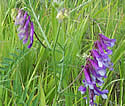 Hairy Vetch plants
Hairy Vetch plants a tangle of hairy vetch
a tangle of hairy vetch an infestation of Hairy Vetch
an infestation of Hairy Vetch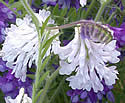 purple and white flowers
purple and white flowers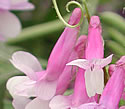 pink flowers
pink flowers more leaves
more leaves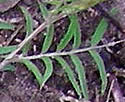 sprawling plant, prior to flowering
sprawling plant, prior to flowering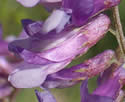 Vicia villosa subsp. varia: hairless calyx with shorter lobes
Vicia villosa subsp. varia: hairless calyx with shorter lobes comparison of Vicia cracca and V. villosa flowers
comparison of Vicia cracca and V. villosa flowers
Photos by K. Chayka taken in Ramsey County and in Mississippi. Photos by Peter M. Dziuk taken in Anoka County. V. villosa fruit by Keir Morse used under CC BY-NC-SA 3.0.
Comments
Have you seen this plant in Minnesota, or have any other comments about it?
on: 2011-06-23 14:02:58
I found this in my yard, growing in the shade. It was actually growing on top of some plants, sort of like ivy. It was really cool.
on: 2011-07-24 11:19:35
Again, everyone thinks these are so pretty, but what a pest they end up becoming. I weed them out before the legumes are formed and dispense with them, too. I've watched over the years, and they don't appear to smother any plants, but can get very entangled and could probably do more damage. So, I just keep weeding them out, too.
on: 2012-04-23 09:02:55
I have them growing in my grove of trees - I replanted them by y pond - opps wrong thing to do - spindley
on: 2014-06-15 18:17:36
I dug this plant from a pasture in Zimmerman and brought it back to my home in Richfield. I was initially concerned about the manner which it spreads, but I have given this purple beauty areas to climb. So far, I think it will be fine. All of my gardening friends agreed that this should only be added if it has an area to climb off thr ground. I will spread this plant along my front porch, hoping it continues to wrap the spindles and provide beauty.
on: 2019-06-07 18:53:34
I know the general idea is that invasive plants just draw a native species however this plant growing on my weedy hillside attract more bees than any other plans I have ever had, so I need more instruction on why it’s so important to remove it…
on: 2019-06-24 10:32:11
I'm pretty sure this is what I was seeing along the Paul Bunyan Trail north of Brainerd.
on: 2019-07-09 16:19:49
Found these on the side of the road. this plant is stunning in full bloom! Wondering if i could and should get it to grow up my large tree trunk. I dont want to plant anything "invasive" in a bad way. I want to attract more pollinators too. Thoughts?
on: 2019-07-09 17:00:17
Amanda, hairy vetch is an exotic species that will expand and create dense mats that can smother other plants. Better to plant natives, most of which are pollinator-friendly and/or hosts for butterflies. If you need help with gardening ideas for pollinators check out Wild Ones, which has several chapters in MN.
on: 2020-06-03 19:31:17
I have been seeing this more and more along Rice Creek North Trail in NW Shoreview. It stretches several feet from its base and grows along the tops of the native prairie species. The county does manage this area with prescribed burns, but it doesn't appear to be reducing the populations.
on: 2021-06-10 23:00:25
I notices quite a bit of this growing in the dog park at Perry Park in arden hills






